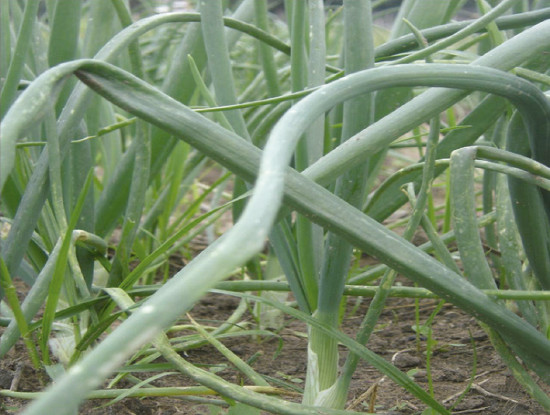Effect of different water levels on the growth and development of bulb onion (<i>Allium cepa</i> L.)

Abstract
Because of the shallow root system of the onion plant, it requires irrigation at the proper time and intensity in order to promote the absorption of water and nutrients to obtain a high yield. We evaluated the irrigation rate effect on onion growth and development in a sandy loam soil with a sprinkler irrigation system. The experiment design was completely randomized with four treatments (evaporation coefficients of 0.8, 1.0, 1.2 and 1.4 of (Ev)), each with 16 repetitions, for 64 experiment units; each experiment unit was a 1 m2 plot. The 1.2 coefficient (43 L per plant per cycle) showed the highest total dry mass and dry mass of the bulb with significant differences from the 0.8 coefficient, but no differences with the application of the 1 and 1.4 Ev. Furthermore, the 1.2 Ev treatment showed the highest root dry mass. There was no significant difference between the treatments during the first 70 days after transplant, but after this time, there was a statistically difference and the 1.2 Ev showed the highest dry matter accumulation.Keywords
Evapotranspiration, water deficit, irrigation coefficient (Kc), dry mass, fresh mass.
References
- Agronet. 2016. Principales departamentos productores de cebolla año 2013. En: http://agronet.gov.co/agronetweb1/Estad%C3%ADsticas.aspx; consulta: agosto de 2017.
- Bekele, S. y K. Tilahun. 2007. Regulated deficit irrigation scheduling of onion in a semiarid region of Ethiopia. Agric. Water Manage. 89(1-2), 148-152. Doi: https://doi.org/10.1016/j.agwat.2007.01.002
- Brewster, J.L. 2008. Onions and other vegetable Alliums. CABI International, Cambridge, MA, USA. Doi: https://doi.org/10.1079/9781845933999.0000
- Enciso, J., B. Wiedenfeld, J. Jifon y S. Nelson. 2009. Onion yield and quality response to two irrigation scheduling strategies. Sci. Hortic. 120(3), 301-305. Doi: https://doi.org/10.1016/j.scienta.2008.11.004
- FAO. 2006. Evapotranspiración del cultivo: guías para la determinación de los requerimientos de agua de los cultivos. FAO, Roma, Italia.
- FAO. 2016. Yield and area of dry onions in 2010. En: Statical database, http://fenix.fao.org/faostat/beta/en/?#data/QC; consulta: agosto de 2017.
- Irfan, M., S. Hayat, Q. Hayat, S. Afroz y A. Ahmad. 2010. Physiological and biochemical changes in plants under waterlogging. Protoplasma 241(1), 3-17. Doi: https://doi.org/10.1007/s00709-009-0098-8
- Kumar, S., M. Imtiyaz y A. Kumar. 2007a. Effect of differential soil moisture and nutrient regimes on postharvest attributes of onion (Allium cepa L.). Sci. Hortic. 112(2), 121-129. Doi: https://doi.org/10.1016/j.scienta.2006.12.024
- Kumar, S., M. Imtiyaz, A. Kumar y R. Singh. 2007b. Response of onion (Allium cepa L.) to different levels of irrigation water. Agric. Water Manag. 89(1-2), 161-166. Doi: https://doi.org/10.1016/j.agwat.2007.01.003
- Medrano, H., J. Galmés y J. Flexas. 2008. Fijación del dióxido de carbono y biosíntesis de fotoasimilados. pp. 211-126. En: Azcón-Bieto, J. y M. Talón (eds.). Fundamentos de fisiología vegetal. McGraw-Hill, Barcelona, España.
- Metwally, A.K. 2011. Effect of water supply on vegetative growth and yield characteristics in onion (Allium cepa L.). Aust. J. Basic Appl. Sci. 5(12), 3016-3023.
- Mishra, R., R.K. Jaiswal y D. Kumar. 2014. Management of major diseases and insect pests of onion and garlic: a comprehensive review. J. Plant Breed Crop Sci. 6(11), 160-170. Doi: https://doi.org/10.5897/JPBCS2014.0467
- Rattin, J.E., S. Assuero, G.O. Sasso y J.A. Tognetti. 2011. Accelerated storage losses in onion subjected to water deficit during bulb filling. Sci. Hortic. 130(1), 25-31. Doi: https://doi.org/10.1016/j.scienta.2011.06.026
- Rodríguez-Galdón, B., C. Tascón-Rodríguez, E.M. Rodríguez-Rodríguez y C. Díaz-Romero. 2009. Fructans and major compounds in onion cultivars (Allium cepa). J. Food Compos. Anal. 22(1), 25-32. Doi: https://doi.org/10.1016/j.jfca.2008.07.007
- Sánchez-Díaz, M. y J. Aguirreolea. 2008. Transpiración y control estomático. pp. 41-56. En: Azcón-Bieto, J. y M. Talón (eds.). Fundamentos de fisiología vegetal. McGraw-Hill, Barcelona, España.
- Sauter, M. 2013. Root responses to flooding. Curr. Opin. Plant Biol. 16(3), 282-286. Doi: https://doi.org/10.1016/j.pbi.2013.03.013
- Shao, H.B., L. Chu, C.A. Jaleel y C.X. Zhao. 2008. Water-deficit stress-induced anatomical changes in higher plants. C. R. Biol. 331(3), 215-225. Doi: https://doi.org/10.1016/j.crvi.2008.01.002
- Steen, S. y N. Benkeblia. 2014. Variation of reducing and total sugars during growth of onion tissues. Acta Hortic. 1047, 51-55. Doi: https://doi.org/10.17660/ActaHortic.2014.1047.3
- Steffens, B. 2014. The role of ethylene and ROS in salinity, heavy metal, and flooding responses in rice. Front. Plant Sci. 5, 685. Doi: https://doi.org/10.3389/fpls.2014.00685
- Taiz, L., E. Zeiger., I.M. Møller y A. Murphy. 2015. Plant physiology and development. 6th ed. Sinauer Associates, Sunderland, MA, USA.
- Thomas, H. 2013. Senescence, ageing and death of the whole plant. New Phytol. 197(3), 696-711. Doi: https://doi.org/10.1111/nph.12047
- Voesenek, L.A.C.J. y R. Sasidharan. 2013. Ethylene and oxygen signalling drive plant survival during flooding. Plant Biol. 15(3), 426-435. Doi: https://doi.org/10.1111/plb.12014
- Zheng, J., G. Huang y J. Wang. 2012. Effects of water deficits on growth, yield and water productivity of drip-irrigated onion (Allium cepa L.) in an arid region of Northwest China. Irrig. Sci. 31(5), 995-1008. Doi: https://doi.org/10.1007/s00271-012-0378-5
Downloads
Download data is not yet available.
